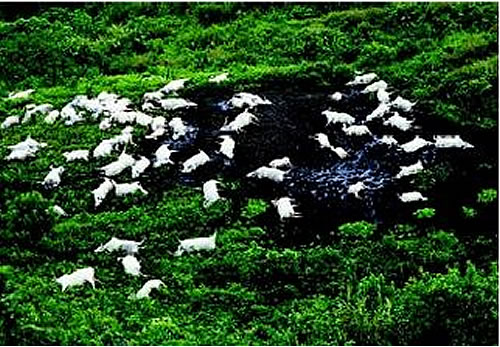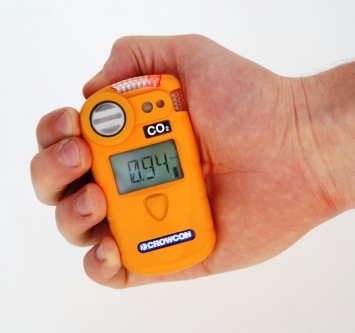Two amateur French wine makers have died after they were suffocated by the fumes from the grapes they were treading with their bare feet.
The victims had volunteered to help a friend make wine at his vineyard in the northern Ardeche region and had climbed into the six-foot wide vat to begin the traditional process of extracting the juice from the grapes.
But police believe Daniel Moulin, 48, and 50-year-old Gerard Dachis were overcome by carbon dioxide fumes that are given off during fermentation and collapsed. ...
It is not unheard of for wine-makers to become overcome by carbon dioxide fumes.
In 2003 a South African man was killed after climbing into a wine tank and suffocating. The four people who tried to save him had to be rushed to hospital. A doctor at the hospital told media at the time that wine makers were regularly overcome by fumes in the tanks.
Carbon dioxide is formed during the alcoholic fermentation of the grapes. Because it is 1.5 times heavier than air it sinks to floor level - the bottom of wine vats or in wine cellars.
The gas is odourless and colourless, meaning that ventilation and carbon dioxide testing during the wine-making process can become life-saving. A concentration of just eight per cent is enough to kill a human being. - dailymail
That's messed up. I lived with a French wine maker for a while, but I didn't know about this danger.
Carbon dioxide content in fresh air (averaged between sea-level and 10 hPa level, i.e. about 30 km altitude) varies between 0.036% (360 ppm) and 0.039% (390 ppm), depending on the location (see graphical map of CO2). ...
I did hear about CO2 killing people by displacing the oxygen in a natural disaster in Cameroon.
A natural disaster linked to CO2 intoxication occurred during the limnic eruptions in the CO2-rich lakes of Monoun and Nyos in the Okun range of North-West Cameroon: the gas was brutally expelled from the mountain lakes and leaked into the surrounding valleys, killing most animal forms. During the Lake Nyos tragedy of 1986, 1700 villagers and 3500 livestock died.[32
Typically the gas we exhale is about 4% to 5% carbon dioxide and 4% to 5% less oxygen than was inhaled.
According to a study by the United States Department of Agriculture, an average person's respiration generates approximately 450 liters (roughly 900 grams) of carbon dioxide per day.[37]
To detect CO2:
The new Gasman CO2 detector from Crowcon is small, light and easy to use. Weighing just 130g - the lightest on the market - it is extremely durable, with high impact resistance and dust/water ingress protection to IP65. The new Gasman CO2 detector from Crowcon is small, light and easy to use. Weighing just 130g - the lightest on the market - it is extremely durable, with high impact resistance and dust/water ingress protection to IP65. When potentially hazardous levels of CO2 are detected the Gasman alerts the user with a loud 95 dBA alarm, an extremely bright red/blue visual warning and also by vibrating.
The detector is ideal for use in industries where CO2 is part of the production process. These include food and beverage manufacturing, brewing, distilling and wine making, pharmaceutical and chemical processing, and also the catering and hospitality industries. -kieson
To remove CO2 from an area:
Various strong bases such as soda lime, sodium hydroxide, potassium hydroxide, and lithium hydroxide are able to remove carbon dioxide by reacting with it. In particular, lithium hydroxide is used aboard space craft to remove carbon dioxide from the atmosphere. It reacts with carbon dioxide to give lithium bicarbonate: - wiki
If you just need O2 at high altitude or during an emergency, Try the tips from AVweb to survive for an hour or more with a small personal oxygen supply:
 Breathe more deeply and less frequently than normal, as divers and mountain climbers are taught to do.
Breathe more deeply and less frequently than normal, as divers and mountain climbers are taught to do.- With its nasal mask (rather than the nasal cannula) to take one or two deep breaths of pure O2, holding it in like a pot smoker to provide time for as much blood as possible to be oxygenated. ... Within about 15 seconds after doing so, the pulse oximeter reading would shoot up to 98% or more, then gradually ebb back toward 90% over a period of minutes, at which point it was time to take another "hit" from the BoL cylinder and start the cycle over again. Using this intermittent deep breathing technique together with oximeter monitoring, I found it possible to keep my "O2 sat" in the safety range with remarkably little oxygen consumption, stretching the endurance of that little 12-ounce oxygen cylinder to several hours.
$200 isn't bad for an hour or more of O2. You could open your own private oxygen bar. I assume that once you own one of these you can get the canister refilled at a SCUBA shop, but I'm not certain. Just do not use this around any flames, obviously.


1 comment:
That's a horrible accident. People should be more careful...
Post a Comment